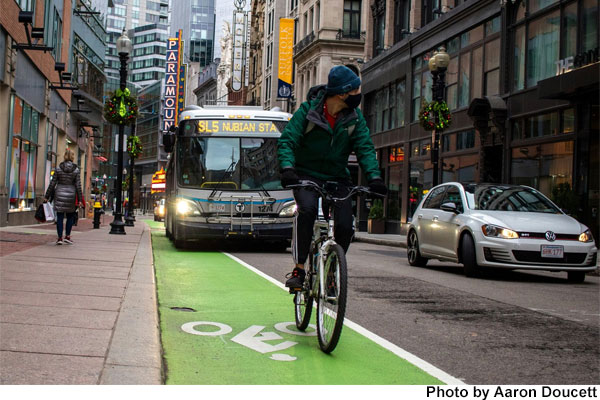Snapshots From the Road | Removing Parking Spaces To Add Bike Lanes
– We are reposting the following article with permission from our friends at BuildingH.org
Adam Rogers begins his piece Bike lanes are good for business by noting the knee-jerk and not unreasonable fear that many small business owners have about adding bike lanes to downtown streets. They, of course, worry that the attendant removal of parking spaces will make it harder for customers to reach them by car, and anything that limits vehicle access to their stores will cut into their sales. It all makes sense, except, as Rogers shows quite clearly in the article, it’s wrong.
Rogers essentially conducted his own meta-analysis, reviewing more than 30 scientific studies over the past few decades, and concluded that bike lanes, on net, are good for business. Yes, some businesses benefit more than others, but the bottom line is that the mental model that associates prioritizing convenient vehicle access with more sales is outdated at best. The problem is convincing people of that. According to Rogers, the best path forward is just to build more lanes – over time the results speak for themselves and the detractors come around.
Looking at ROI from another lens, a recent study of the impact of “low-traffic neighborhoods,” or LTNs, in London found that the associated health benefits were 100x the cost of implementing the changes. (LTNs use signs and physical barriers to prevent motor vehicles from traveling through small residential streets but enable people on bikes and pedestrians to pass through.) According to this report in The Guardian, the gains came from changes in daily habits (lower automobile ownership, less driving, more walking and biking), leading to better health and reduced workplace illness. (You can see this sort of experiment in the US at Culdesac Tempe, a car-free neighborhood that took the top spot in our 2022 Building H Index and which was recently profiled in Fast Company.)
Finally, another perspective on the benefits of reducing parking comes from Hoboken, New Jersey, where, as part of a broader effort to reduce or even eliminate “pedestrian fatalities” (aka people killing people by hitting them with their cars), they removed parking spaces near intersections. There has been the predictable blowback from businesses who decry the less convenient vehicle access, but Hoboken has had spectacular results – there hasn’t been a vehicle-involved pedestrian death there since 2017.
Happily, Rogers’s work to plumb the research led to a positive conclusion – health-supporting infrastructure is also good for business. In other words (perhaps less healthy words) we can have our cake and eat it, too. Tastes great and less filling. But what if the opposite were true? What if it were clear that the cost of the health benefits from more bicycle- and pedestrian-oriented infrastructure were economic losses? Would we choose health? Or, as the designers like to say, “how might we choose health?”
– Steve & Thomas
